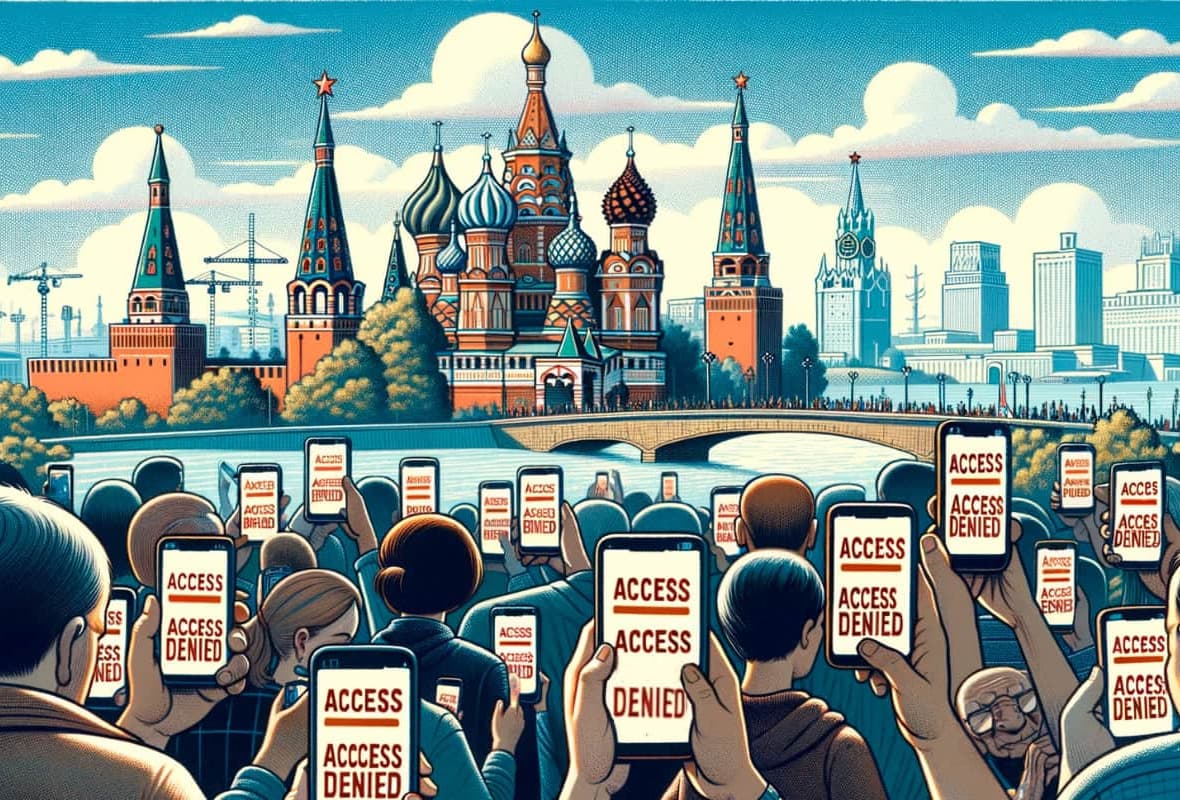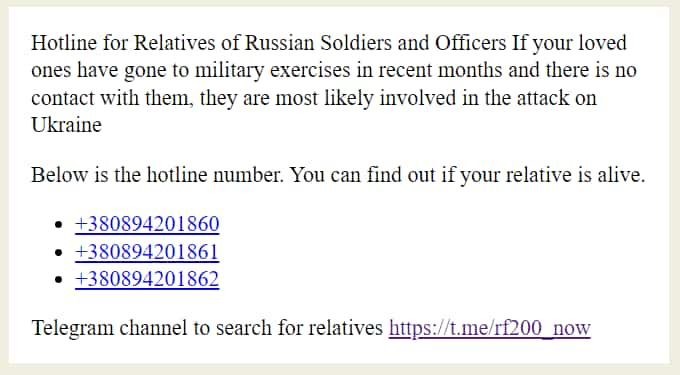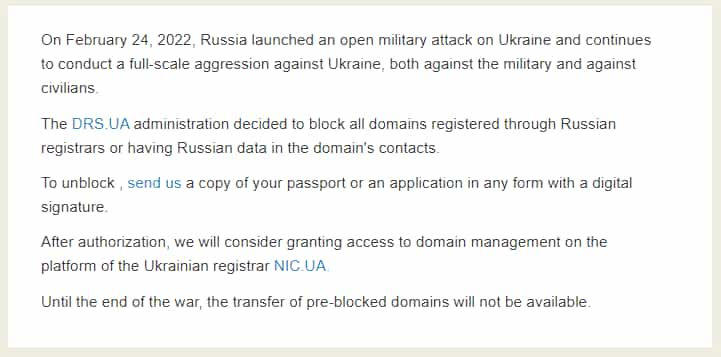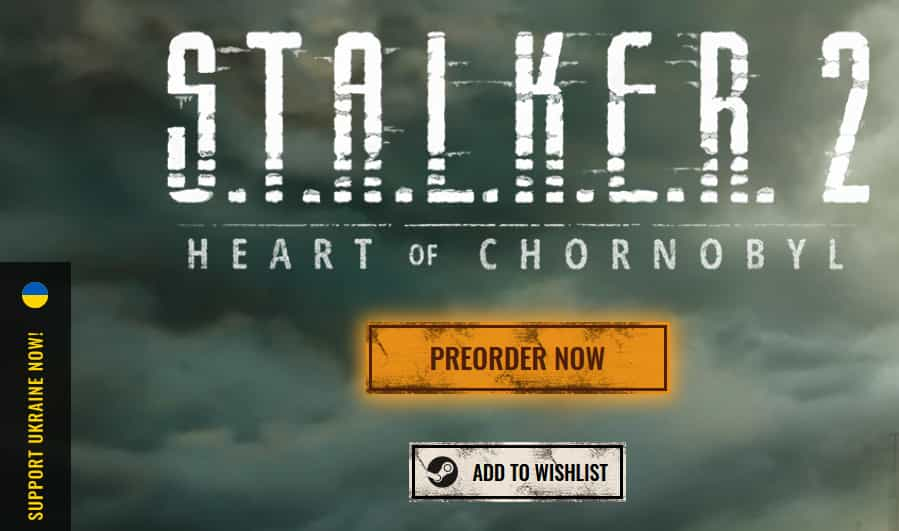Websites Blocked in Russia Since February 2022
We are tracking the websites officially blocked in Russia since February 2022, including Instagram, Facebook and major news sites.

First published Mar 2, 2022. Last updated to incorporate the latest sites blocked in Russia, including the Discord group chat platform.
- At least 4,458 websites have been blocked in Russia since February 2022 for reasons relating to Ukraine.
- Notable website bans: YouTube, Instagram, Facebook, X (Twitter), Discord, The Internet Archive, FBI, CIA, Google News, BBC News, NPR, Der Spiegel, RAI, AOL, Ukrayinska Pravda, Meduza.io, AFP, Radio Liberty/Radio Free Europe sites, Voice of America, Clarin.com, Quora, Amnesty International and Chess.com.
- Ukrainian internet domains (1,080 excl. mirror domains) were the most frequently blocked, followed by Russia (379) and the U.S. (104).
- News websites: 3,617 internet domains now blocked:
- 636 Ukraine news websites, including 208 local news outlets and 117 national news websites.
- 196 Russian news services, including 60 independent news websites.
- 21 public broadcaster websites from around the world.
- 208 foreign news websites based in 39 countries outside of Russia and Ukraine.
- Digital resistance: Russia has blocked 541 internet domains featuring counter-propaganda or online messages of support for Ukraine, including:
- 255 hijacked internet domains displaying counter-propaganda messages.
- 122 counter-propaganda websites often showing graphic images.
- 62 sites showing support for Ukraine, many of which are limited to simple banners or badges.
- Anti-censorship tools: authorities have blocked 115 domains relating to VPNs, proxies and other censorship circumvention resources.
- 36 civil society sites, including Amnesty International, Human Rights Watch and 16 Ukrainian charities and other non-profits.
- 25 government internet domains, including Ukraine’s Office of the President website, the official website of Ukraine and the nation’s Health Ministry site, along with the FBI and CIA websites in the U.S.
Internet Censorship in Russia
Since February 2022, Russian authorities have sought to dramatically restrict the free flow of information online in their own country, with the Prosecutor General’s Office ordering local Internet Service Providers (ISPs) to block over 25,000 websites.
Our goal has been to analyze this vast blocklist and document the websites that have been blocked for reasons relating to Ukraine in the hope of keeping a spotlight on Russia’s increasingly severe internet censorship.
ISPs have adopted various techniques to block content Russia, including HTTP man-in-the-middle interference and DNS manipulation, with varying degrees of success.
The most common approach has been DNS based filtering and RST packet injection during TLS handshakes, according to The Open Observatory of Network Interference (OONI).[1] While officials often only identify a specific URL for blocking, the mechanisms used to restrict access by ISPs frequently mean the entire domain is rendered inaccessible.
Many of the websites identified for blocking since February 2022 are unrelated to Ukraine, including gambling and adult websites. However, our analysis of blocked domains reveals a significant number were restricted because of content directly related to the situation there.
The banned sites are accessible via an online database maintained by the Russian NGO, Roskomsvoboda, at reestr.rublacklist.net.
From large international public broadcasters, such as the BBC, to local independent news outlets, almost 4,500 websites have been blocked since February 2022. Social media platforms, including Facebook, Instagram, YouTube and Discord have also been affected, alongside a huge variety of smaller websites.
The restrictions have had significant economic repercussions for the country, with the social media blocks costing the economy over $21.5 billion in 2022 alone according to our estimates.
As a result of the widespread blocks, Russians are turning in increasing numbers to virtual private network services, despite official restrictions on their use in the country. Daily demand for VPNs skyrocketed by over 2,000% in late February 2022.
VPN access remains a sensitive issue in Russia. Use of the software is permitted but accessing blocked content is illegal. With at least 15 VPN services currently officially banned for not complying with government demands, it can be difficult to find a trustworthy VPN that still works in Russia.
In 2024, Russian authorities began blocking VPN domains in earnest, adding over 100 to the registry over a period of months, along with proxy sites and Tor-related domains.
See the full list of blocked domains.
Highest Traffic Websites Blocked By Russia
The following table shows the 30 biggest domains by internet traffic added to Russia’s internet denylist since February 2022, along with their locale and type of website. See the full list of blocked domains.
Jump to table showing breakdown of blocked domains by type of website
Jump to table showing top 10 countries by number of domains blocked by Russia since 24 February 2022.
Blocked News Websites: Analysis
The following table shows a breakdown of the internet domains of news websites blocked by Russia since 24 February 2022.
“Mirror domains” refers to alternative domains spun up in a bid to allow continued access to blocked new services. Websites with multiple potential categories have been classified according to their primary characteristic.
Russia has blocked more news services by far than any other type of domain. Over 80% of the domains blocked since February 2022 that relate to what’s happening in Ukraine are those of news websites.
A significant portion of these blocks have been of mirror domains with generic or semi-generic names, such as d1q41g9t686yni.cloudfront.net and svobobzlebokntcgs.azureedge.net.
This is largely a result of the ongoing cat-and-mouse game between Russian censors and the US-funded Radio Liberty/Radio Free Europe (RL/RFE) group of websites, whose main domains were among the first to be blocked in the censorship crackdown.
These mirror domains are spun up quickly and circulated on social media to provide continued access to RL/RFE websites such as radiosvoboda.org and sibreal.org that serve Ukraine, Russia and the Caucasus region. As quickly as Roskomnadzor can block these alternative versions, new mirror domains spring up to replace them, with those blocked typically then taken offline.
Other news sites, such as Mediazona and the BBC, have since adopted a similar strategy.
While this phenomenon has greatly inflated the number of news domains, 1,040 other news domains have been blocked. Russia has taken an extreme approach to censoring internet news, blocking everything from tiny local blogs to major international broadcasters.
Russia has taken particular aim at public broadcasters, blocking 21 such news services from 15 countries:
- bbc.com (UK)
- npr.org (U.S.)
- dw.com (Germany)
- yle.fi (Finland)
- rfi.fr (France)
- svt.se (Sweden)
- rtv.es (Spain)
- nos.nl (Netherlands)
- rai.it (Italy)
- rte.ie (Ireland)
- der.orf.at (Austria)
- polskieradio.pl (Poland)
- golosameriki.com (U.S.)
- hromadske.ua (Ukraine)
- rus.lsm.lv (Latvia)
- rus.err.ee (Estonia)
- golos.com.ua (Ukraine)
- bbcrussian.com (UK)
- uatv.ua (Ukraine)
- golos-ameriki.ru (U.S.)
- ukrainian.voanews.com (U.S.)
Roskomnadzor has also heavily censored local news from Ukraine, and to a lesser extent from Russia. Prominent banned websites include poltava.to, which has over 600,000 monthly visitors, despite the majority of its content covering mundane local issues in the central Ukrainian city of Poltava.
Other major banned websites include Melitopol local news website ria-m.tv, which has around 1.2 million monthly visitors.
The Russian authorities have also clamped down on Russian news websites, with independent media like Meduza.io hardest hit. In total we found 50 Russian independent news websites to have been blocked since February.
Note that we classified independent news websites as primarily journalist-driven, as opposed to the more commercial advertising-focused news websites that typically source much of their content from third-party sources.
Outside of Ukraine, Russia and the U.S., the countries with the most blocked news websites have been:
- Belarus (27 domains)
- Latvia (14)
- Moldova (14)
Other notable trends include the censorship of 12 sports domains and two chess websites for hosting content critical of Russia.
Censorship of Digital Resistance: Analysis
The following table provides a breakdown of websites blocked in Russia that we have classified as contributing to Ukraine’s digital resistance.
Site Hijacking
A key element of what we have dubbed the “digital resistance” to Russia’s actions in Ukraine, and which Roskomnadzor has blocked with gusto, is site hijacking. This is where hackers have targeted low-quality vulnerable websites, seized control and replaced the content with some form of counter-propaganda.
We found 255 blocked domains where the website content has been replaced. More than 30 of these were Russian domains, whose content had all been replaced with the same simple one page website with the following message:

Hijacked Russian website showing hotline details.
The name of the Telegram channel rf200_now is very similar to Ukraine government-operated counter-propaganda website 200rf.com, also blocked, which suggests state actors could be behind the hijacking.
The most frequently blocked hijacked websites (over 200 to date) also appear to be the work of Ukrainian state actors, who have seized and replaced the content of Russian registered websites on the .ua top-level domain with the following message:

Blocked Russian-registered website on .ua top-level domains that have been hijacked, purportedly by Ukraine state actors.
Russian authorities have also blocked 122 websites dedicated to countering the domestic propaganda that seeks to frame what’s happening in Ukraine as justified.
These websites range from impassioned calls for peace to graphic photographs of casualties from both sides. While the majority of these websites originate from the Ukraine, 35 are Russian in origin.
VPNs, Proxies and Tor
Authorities also blocked 115 anti-censorship tools, including 102 VPN domains.
Most of these blocks were implemented over a few months in 2024 and targeted domains and IP ranges of some very popular VPN services, including:
- ExpressVPN
- Proton VPN
- PIA
- Windscribe
- Lantern
- TurboVPN
- Hide.me
- PureVPN
NOTE: Blocking a VPN provider’s main domain does not necessarily stop the VPN service itself from functioning. Rather, it makes it more difficult to download the software and subscribe to the service.
Blocking IP ranges does prevent users from connecting to those VPN servers but a high-quality VPN service will quickly spin up new servers on accessible IPs.
Other Forms of Digital Dissidence
Roskomnadzor has also censored a growing handful of websites promoting even more overt Russian dissidence. ostanovivagony.info, for example, provides explicit instructions on how to sabotage transport infrastructure.
Russia has also blocked several Ukrainian websites aiming to drum up grassroots digital resistance through DDoS attacks on hostile Russian websites, such as the Ukraine government-supported help-ukraine-win.com.ua website, which provides step-by-step instructions and tools for ordinary people to launch such cyber attacks from their personal devices.
Simply showing any kind of support for Ukraine is also enough to draw the attention of Russia’s internet censors, with 62 websites blocked for even the smallest public indicators of support, such as the simple banner below.

Screenshot of video game website blocked in Russia for featuring a message of support for Ukraine.
Types of Website Blocked by Russia
The following table provides a summary by content type of the domains added to Russia’s internet denylist since February 2022.
Countries With Most Blocked Domains
The following table lists the 10 countries host to the highest number of domains added to Russia’s internet denylist since 24 February 2022. Domains were considered to be associated with a country based on their top-level domains or, where known, the physical location of operations.
Note: 2,415 domains originating in the United States are mirror domains for blocked Radio Liberty/Radio Free Europe and Voice of America domains. Other mirror domains are included in the totals for Russia (118), Ukraine (17), UK (13) and Belarus (2)
Methodology
In this ongoing tracking project, we regularly review all entries on reestr.rublacklist.net from 24 February 2022 and filter for domains relevant to what’s happening in Ukraine. We exclude all content that is otherwise routinely blocked in Russia, such as unlicensed gambling or financial scam sites.
The relevant content was then manually reviewed and categorized by site type. Locale was derived from the top-level domain where possible, otherwise it was based on the physical location of the operator of the domain.
“Mirror domains” refers to alternative domains spun up in a bid to allow continued access to blocked new services. Websites with multiple potential categories have been classified according to their primary characteristic.
See the full list of blocked domains.
The authors of all our investigations abide by the journalists’ code of conduct.
References
[1] https://ooni.org/post/2022-russia-blocks-amid-ru-ua-conflict/ ↩